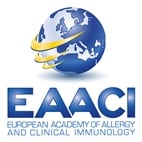Journal list menu
Export Citations
Download PDFs
ISSUE INFORMATION - TOC
EDITORIAL
Harnessing mass spectrometric methods for exquisite allergen product characterization
- Pages: 3189-3191
- First Published: 26 September 2024
REVIEW ARTICLE
The epithelial barrier theory and its associated diseases
- Pages: 3192-3237
- First Published: 07 October 2024
Epithelial barrier dysfunction and associated diseases in companion animals: Differences and similarities between humans and animals and research needs
- Pages: 3238-3268
- First Published: 17 October 2024
The influence of lifestyle and environmental factors on host resilience through a homeostatic skin microbiota: An EAACI Task Force Report
- Pages: 3269-3284
- First Published: 01 November 2024
Monkeypox 2024 outbreak: Fifty essential questions and answers
- Pages: 3285-3309
- First Published: 04 November 2024
Subcutaneous adipose tissue: Implications in dermatological diseases and beyond
- Pages: 3310-3325
- First Published: 29 August 2024
From bite to brain: Neuro-immune interactions in food allergy
- Pages: 3326-3340
- First Published: 27 October 2024
ORIGINAL ARTICLE
Basic and Translational Allergy Immunology
Multimodal profiling of biostabilized human skin modules reveals a coordinated ecosystem response to injected mRNA-1273 COVID-19 vaccine
- Pages: 3341-3359
- First Published: 19 August 2024

Biostabilized human skin modules are preserved immunocompetent over 10 days and allow the monitoring of the immune response to mRNA vaccine at the injection site. Single-cell RNA sequencing reveals that mRNA-1273 COVID-19 vaccine is preferentially incorporated into DC/macrophages and mast cells in human skin modules 8 h after injection. Upon vaccine injection, skin-resident dendritic cells and Langerhans cells acquire biomarkers of mature antigen-presenting cells and of homing to lymph nodes. Abbreviations: APC, antigen presenting cell; COVID-19, coronavirus disease 2019;DC, dendritic cell; GM-CSF, granulocyte-macrophage colony-stimulating factor;IL-6, interleukin 6; LC, Langerhans cell; MC, mast cell; MCP-1, macrophage/monocyte chemotactic protein-1; MDC, macrophage-derived chemokine; TARC, thymusand activation-regulated chemokine.
Infantile colic is associated with development of later constipation and atopic disorders
- Pages: 3360-3372
- First Published: 19 August 2024
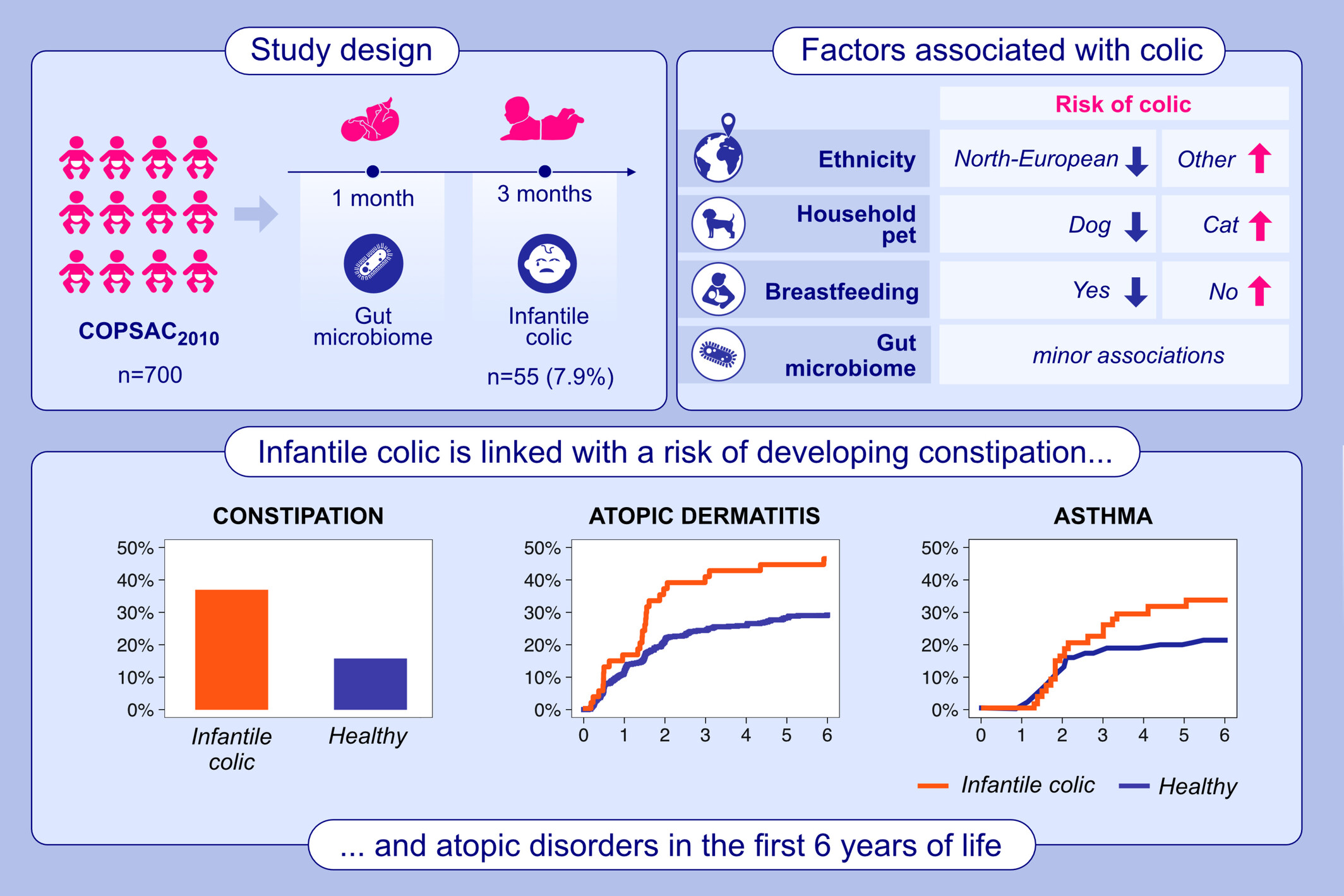
In a deeply phenotyped Copenhagen Prospective Studies on Asthma in Childhood2010 population, we evaluated early life factors and gut microbiota in relation to the development of infantile colic and the risk of developing later gastrointestinal and atopic manifestations. We link several factors including race, breastfeeding, and pets with infantile colic, which is in turn associated with a higher risk of developing constipation, asthma, atopic dermatitis, and allergic sensitization in the first 6 years of life. The 1-month gut microbiome composition was associated with colic but did not mediate the risks of long-term outcomes.Abbreviation: COPSAC2010, Copenhagen Prospective Studies on Asthma in Childhood2010.
Endogenous Glucagon-Like Peptide-1 Receptor and Glucose-Dependent Insulinotropic Polypeptide Receptor Signaling Inhibits Aeroallergen-Induced Innate Airway Inflammation
- Pages: 3373-3384
- First Published: 19 November 2024
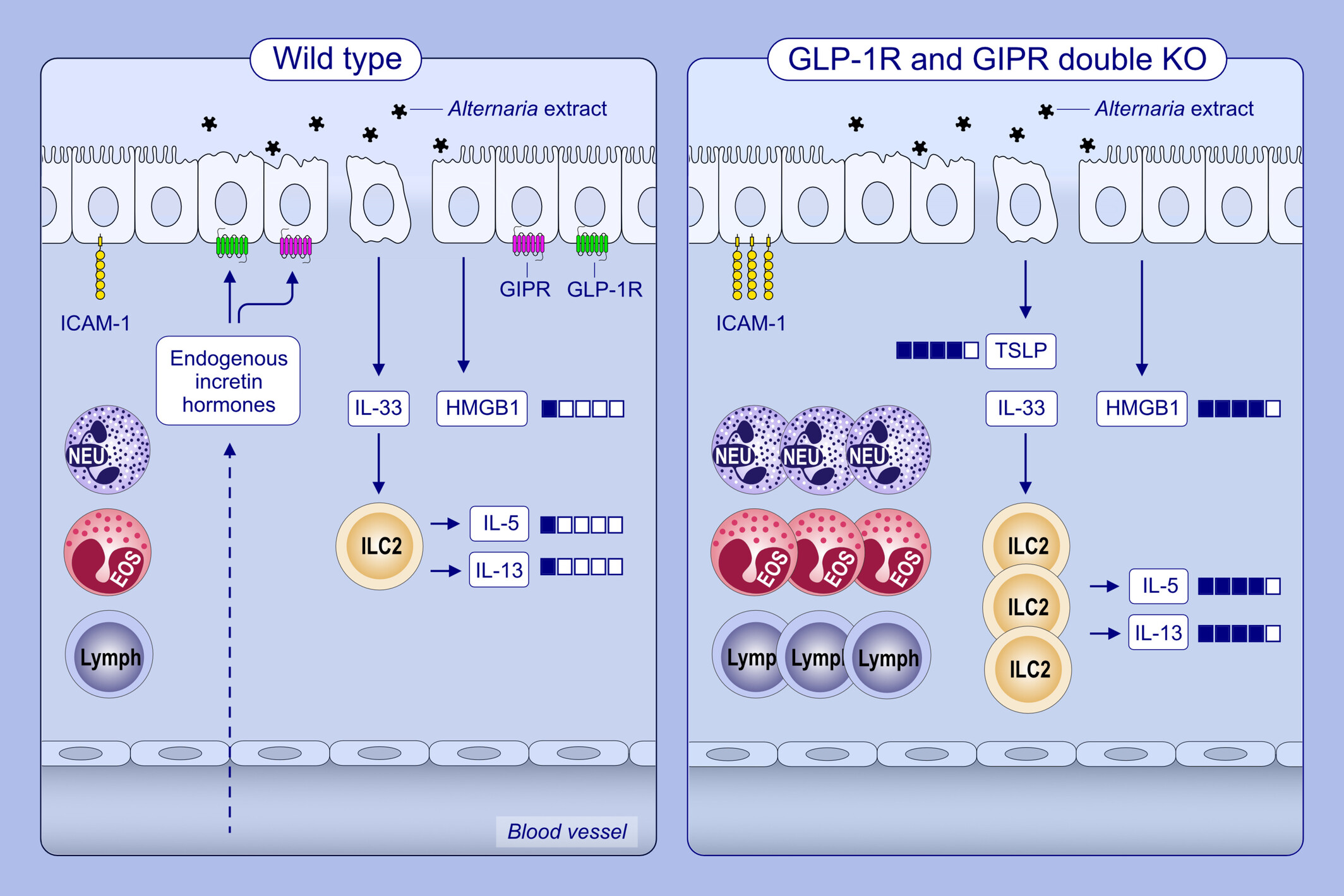
This study investigates the role of endogenous signaling through either one or both, of the GLP-1R and GIPR in regulating allergic airway inflammation. The simultaneous loss of GLP-1R and GIPR signaling leads to increased TSLP release, a higher number of lung ILC2 cells, eosinophils, lymphocytes, and neutrophils in the airway, as well as elevated expression of type 2 cytokines (IL-5 and IL-13), HMGB1, and ICAM-1 in lung epithelial cells, compared to other mouse strains following exposure to Alternaria extract. These data suggest that basal incretin signaling has a role of anti-allergic inflammation in the lung.Abbreviations: EOS, eosinophil; GIPR, glucose-dependent insulinotropic polypeptide receptor; GLP-1R, glucagon-like peptide-1 receptor; HMGB1, high mobility group box 1; ICAM-1, intercellular adhesion molecule 1; IL, interleukin; ILC2, group 2 innate lymphoid cell; incretins, hormones that stimulate insulin secretion; NEU, neutrophil; Lymph, lymphocyte; TSLP, thymic stromal lymphopoietin.
Rhinitis, Sinusitis, and Upper Airway Disease
Epigenetic training of human bronchial epithelium cells by repeated rhinovirus infections
- Pages: 3385-3400
- First Published: 08 November 2024
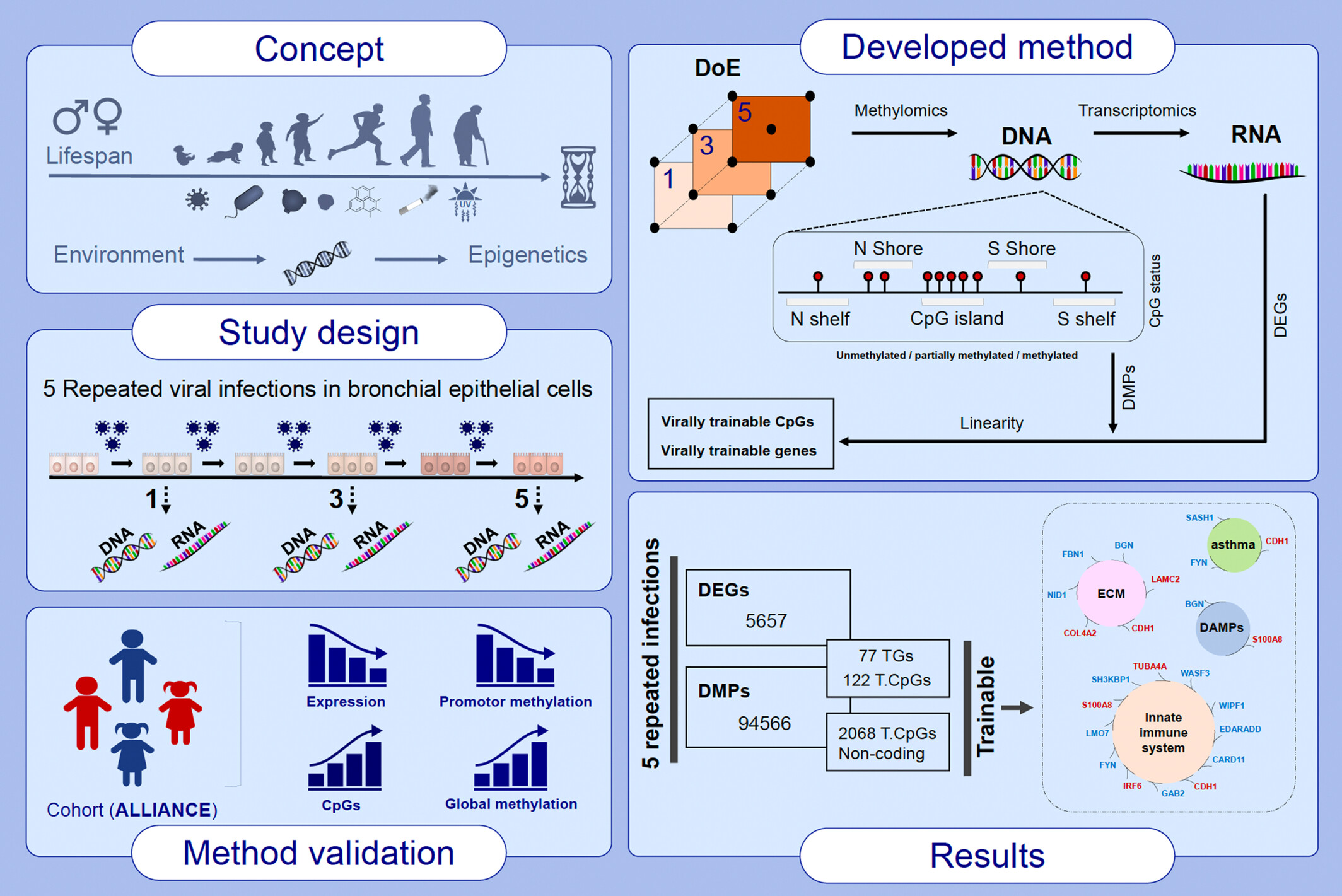
This study aimed to identify trainable genes responsive to repeated HRV infections by examining changes in DNA methylation and gene expression in human bronchial epithelial cells (BEAS-2B). By using an innovative experimental design (DoE) and integrating transcriptome and methylation data, the developed method successfully served as a prediction model. Key findings included the identification of 77 trainable genes (TGs). The tracking of TGs methylation sites within an asthmatic pediatric cohort revealed differential associations with disease status and age. Additionally, distinct methylation sites associated with asthma and age highlight potential biomarkers for early diagnosis and future therapeutic targets. Abbreviations: ALLIANCE, all-age asthma cohort; BEAS-2B, human bronchial epithelium cell line; DAMPS, damage-associated molecular pattern; DEGs, differentially expressed genes; DMPs, differentially methylated probes; DoE, design of experiments; ECM, extracellular matrix; HRV, human rhinovirus; TGs, trainable genes.
Atopic Dermatitis, Urticaria and Skin Disease
Alopecia areata exhibits cutaneous and systemic OX40 activation across atopic backgrounds
- Pages: 3401-3414
- First Published: 08 August 2024
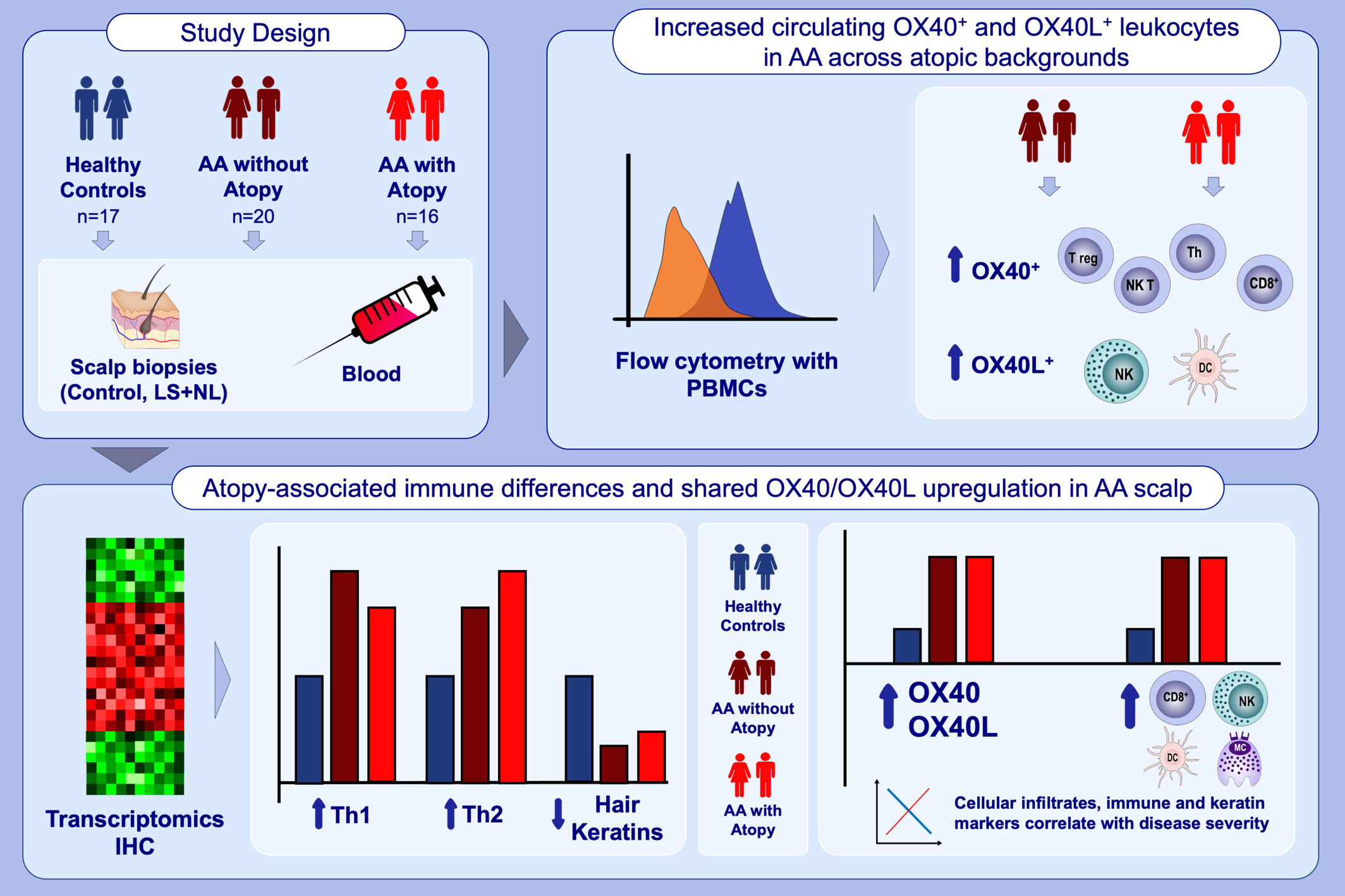
This study evaluated the molecular and cellular profiles of the scalp and blood of patients with alopecia areata (AA), stratified by atopic background. AA scalp was characterized by strong upregulation of OX40/OX40L and Th1 and Th2 with greater inflammatory tone and Th2-skewing in the setting of atopy. Circulating OX40+ and OX40L+ leukocytes were increased in AA, regardless of atopy.Abbreviations: AA, alopecia areata; DC, dendritic cell; IHC, immunohistochemistry; LS, lesional; MC, mast cell; NL, non-lesional; NK, natural killer cell; NK T, natural killer T cell; OX40, CD134/tumor necrosis factor receptor superfamily, member 4 (TNFRSF4); OX40L, OX40 ligand; PBMC, peripheral blood mononuclear cell; Th, T-helper; Treg, regulatory T cell.
A microarray-based IgE-molecular mimicry index (IgE-MMI): A biomarker for disease severity, clinical phenotypes, and therapeutic response in atopic dermatitis?
- Pages: 3415-3429
- First Published: 04 November 2024
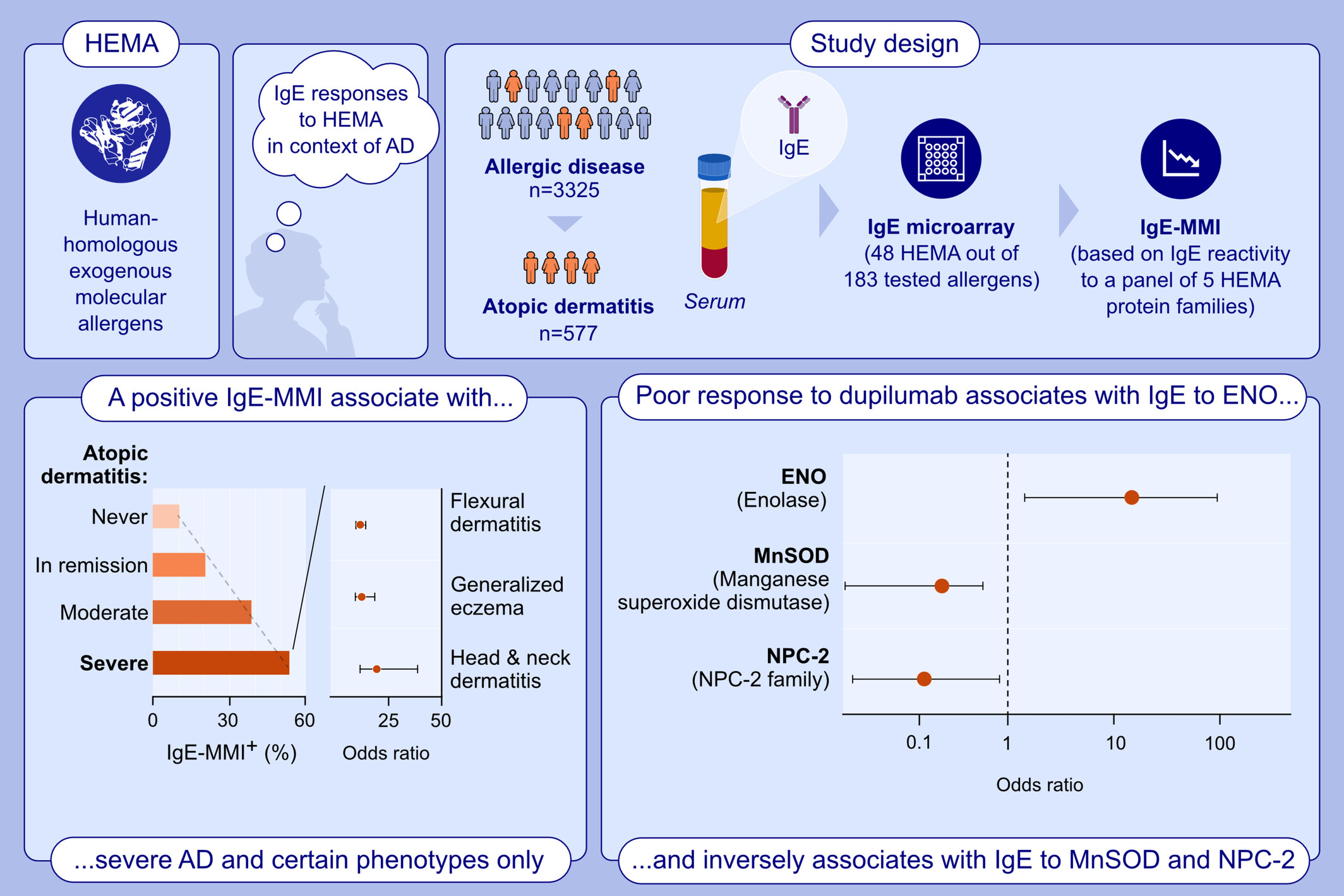
This study investigates whether IgE antibody responses to HEMA are associated with AD, its severity and response to dupilumab. IgE-MMI is associated with severe AD, particularly in flexural dermatitis, head and neck dermatitis, and generalized eczema. Poor response to dupilumab is associated with IgE antibodies to ENO, but inversely associated with IgE antibodies to MnSOD and NPC-2 from dust mites.Abbreviations: AD, atopic dermatitis; ENO, enolase; IgE-MMI, IgE-molecular mimicry index; HEMA, human-homologous exogenous molecular allergens; MnSOD, manganese superoxide dismutase; NCP-2, NPC-2 family.
Food Allergy and Gastrointestinal Disease
The impact of high-IgE levels on metabolome and microbiome in experimental allergic enteritis
- Pages: 3430-3447
- First Published: 23 June 2024
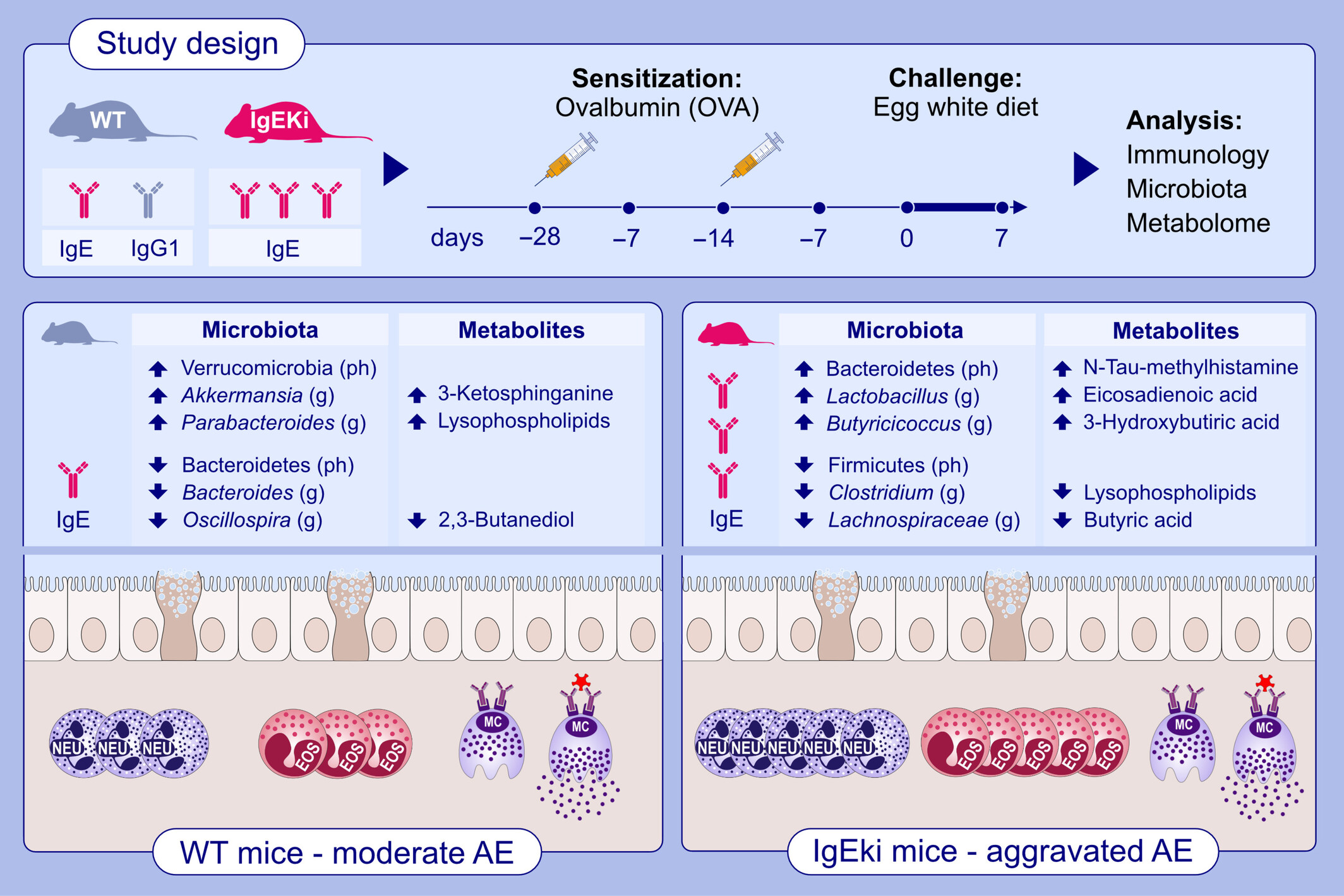
Distinctive metabolome and microbiome signatures were detected among different degrees of AE in WT mice and IgEki mice expressing high levels of IgE. IgEki mice exacerbated AE development with altered levels of lipids including sphingolipids, glycerophospholipids and fatty acids and histamine derivative. The exacerbated AE was accompanied with reduced Clostridium and increased Lactobacillus. These findings contribute to establishing AE diagnostics and therapies. Abbreviations: AE, allergic enteritis; g, genus; Ig, immunoglobulin; IgEki, IgE knock-in; ph, phylum; WT, wild type.
Proton pump inhibitor effect on esophageal protein signature of eosinophilic esophagitis, prediction, and evaluation of treatment response
- Pages: 3448-3463
- First Published: 02 August 2024
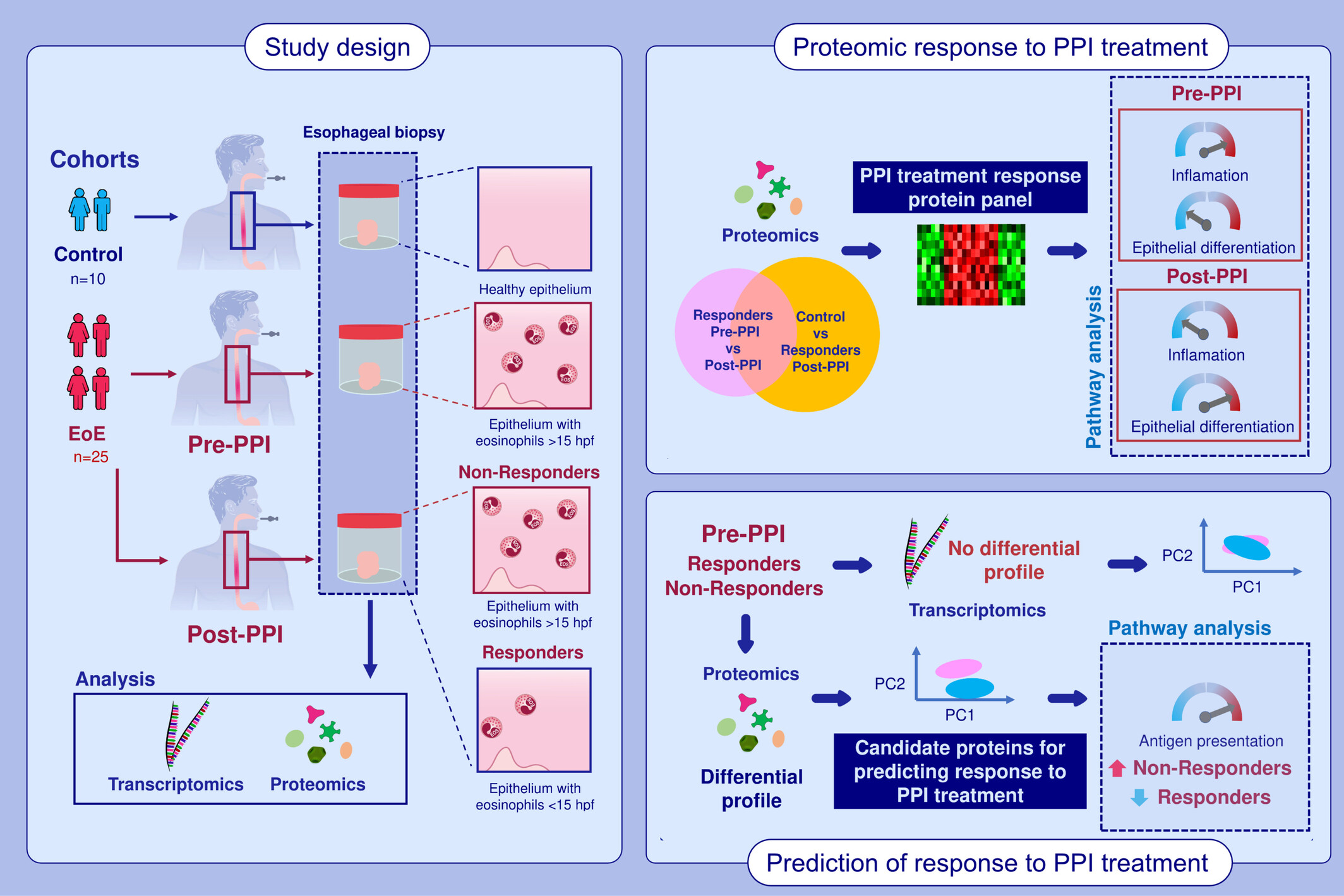
Proteomics and transcriptomics were used to investigate changes in esophageal epithelium from EoE responder and non-responder patients prior and after PPI treatment. A set of proteins, mainly related to inflammatory and epithelial differentiation processes, were detected as differentially expressed in PPI responders after treatment. Proteins related to antigen presentation were differentially expressed between responders and non-responders at baseline. Abbreviations: EoE, eosinophilic esophagitis; hpf, high-power field; mRNA, messenger RNA; PostPPI, after PPI treatment; PrePPI, before PPI treatment; PC, principal component; PPI, proton pump inhibitors.
Biomarkers for a less invasive strategy to predict children with eosinophilic esophagitis
- Pages: 3464-3474
- First Published: 19 August 2024
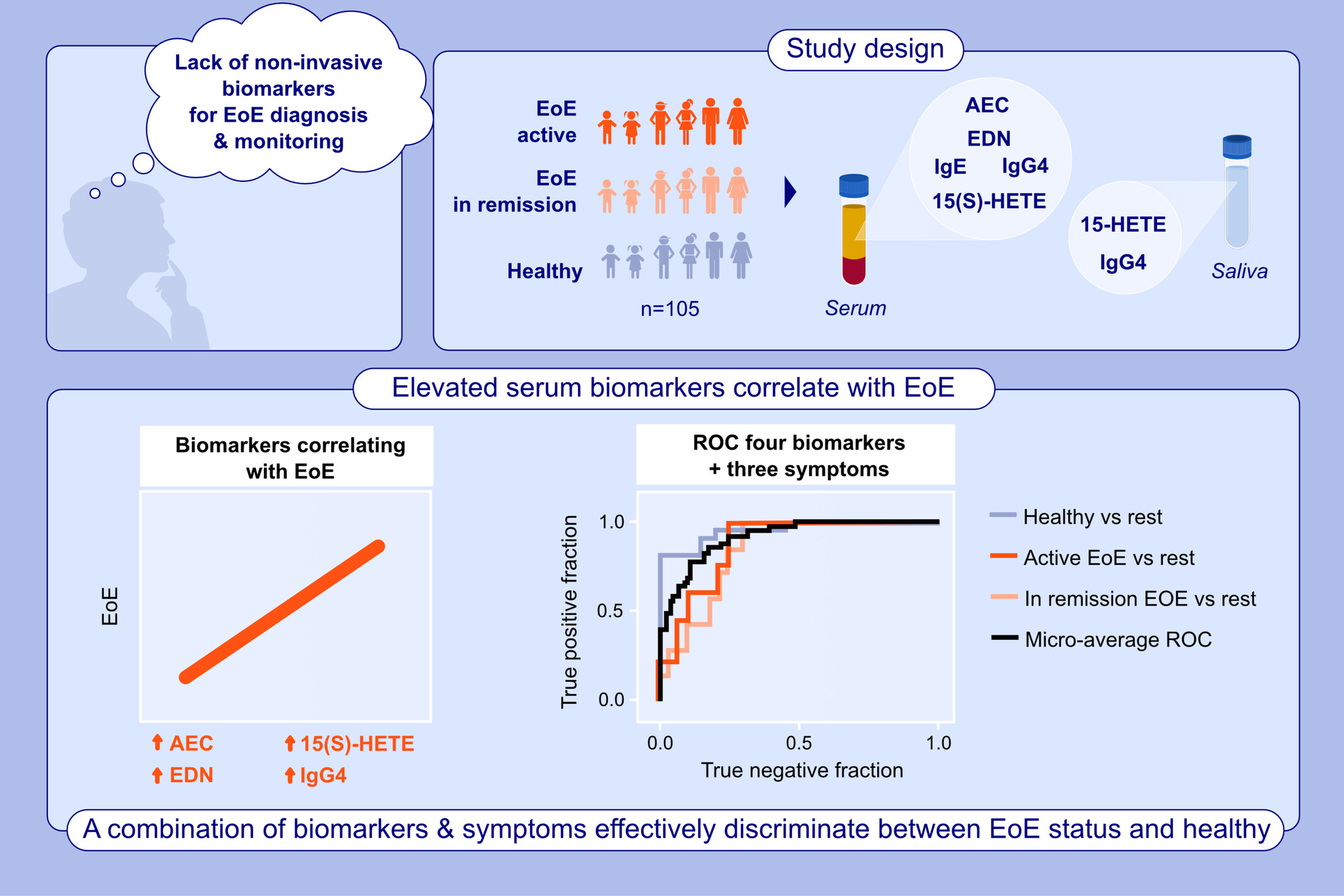
This study evaluates 20 biomarkers in serum and saliva, aiming to assess their diagnostic potential in pediatric EoE patients and healthy individuals. We identified serum biomarkers associated with EoE: AEC, EDN, 15(S)-HETE, sIgG4, and sIgE. Symptoms along with elevated levels of AEC, sIgE to egg white/wheat, differentiate between EoE status and healthy.Abbreviations: AEC, absolute eosinophil count; EDN, eosinophil-derived neurotoxin; EoE, eosinophilic esophagitis; ROC, receiver operating characteristic; sIg, specific immunoglobulin; 15(S)-HETE, 15-hydroxyeicosatetraenoic acid.
Maternal allergy-preventive diet index, offspring infant diet diversity, and childhood allergic diseases
- Pages: 3475-3488
- First Published: 28 August 2024
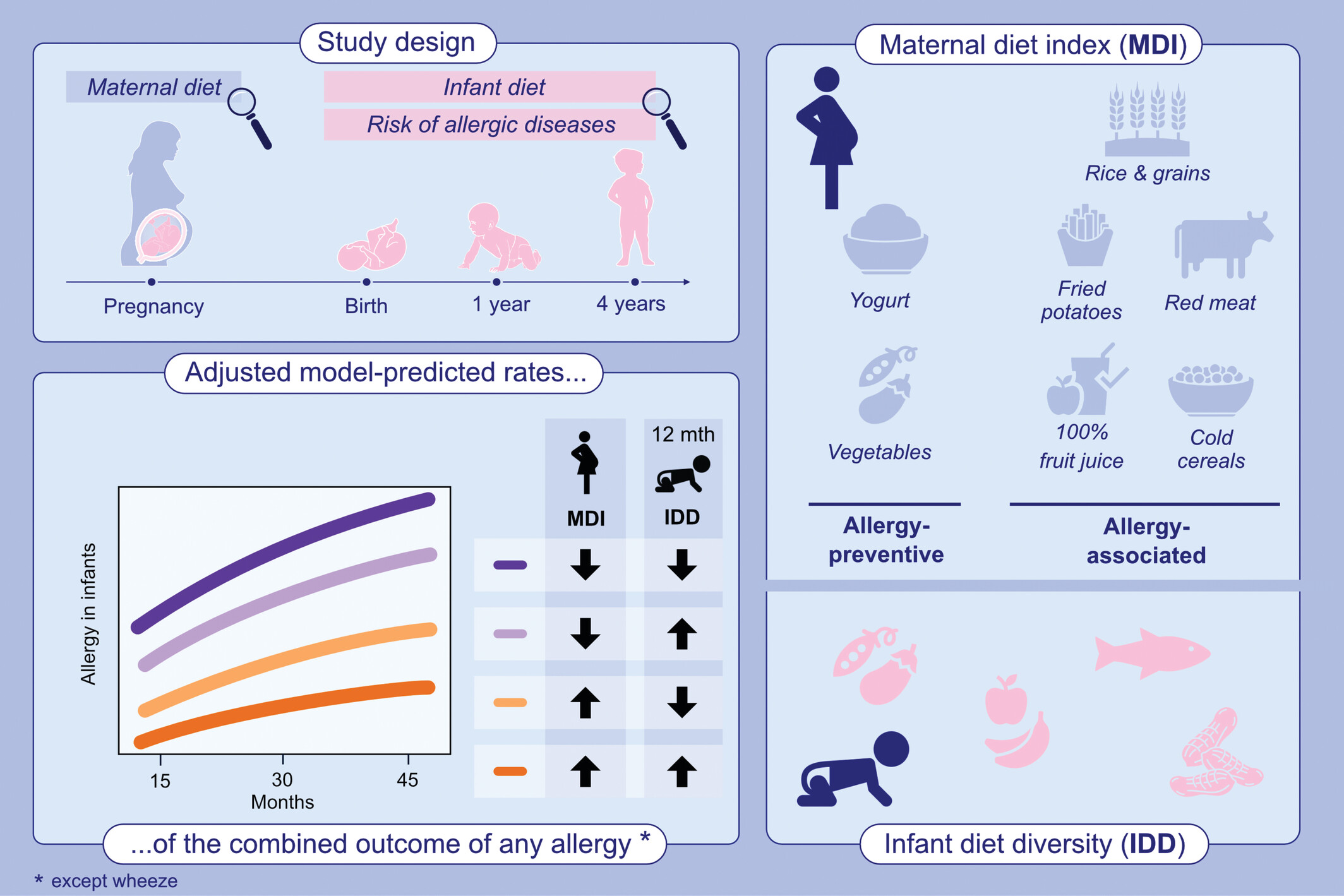
This study investigated associations between diet and allergic disease outcomes. Maternal and infant diet were self-reported. Adjusted parametric Weibull time-to-event models assessed associations between maternal diet index, infant diet diversity, and time to development of allergic rhinitis, atopic dermatitis, asthma, wheeze, IgE-mediated food allergy, and a combined outcome of any allergic disease except for wheeze. The lowest risk of all infant allergy outcomes which included allergic rhinitis, atopic dermatitis, asthma, and IgE-mediated food allergy, was seen when both pregnant women had a higher maternal diet index score and infants had a more diverse diet. Abbreviations: IDD, infant diet diversity; IgE, immunoglobulin E; MDI, maternal diet index.
Autoimmunity and Clinical Immunology
Improved quality control of allergen products: Assessing the molecular allergen composition by mass spectrometry
- Pages: 3489-3500
- First Published: 24 October 2024
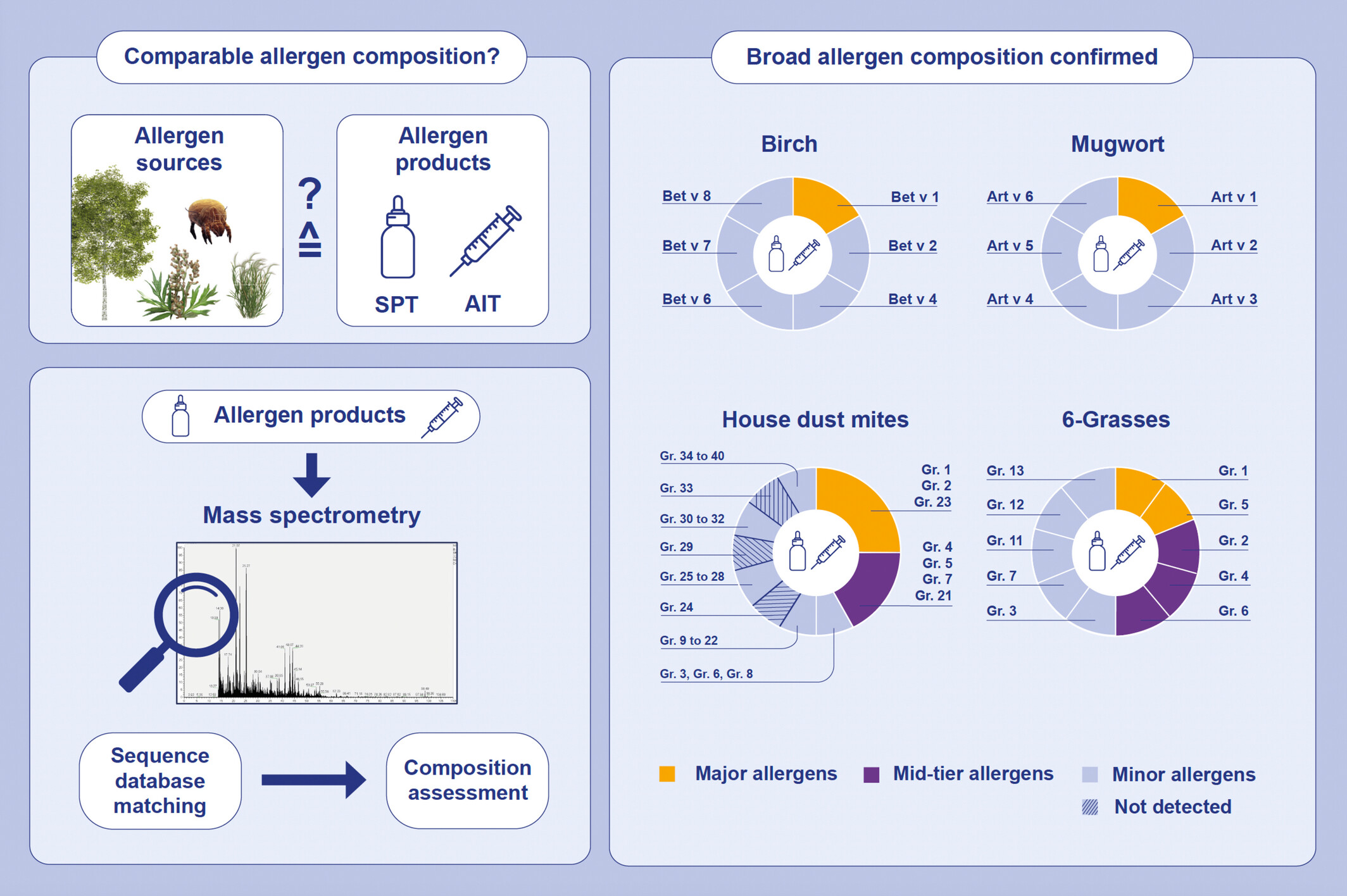
To investigate the completeness of the qualitative allergen composition of diagnostic skin prick tests and therapeutic allergen immunotherapy products manufactured from various allergen sources, a consistent high-resolution mass spectrometry method was applied. Allergens were identified by publicly accessible protein sequence databases. The presence of all major, all mid-tier and most minor allergens was confirmed in the analysed allergen products.
Abbreviations: AIT, allergen immunotherapy; SPT, skin prick test.
LETTER
Transcriptomic profiles of well-differentiated airway epithelial cells in response to environmental triggers of asthma exacerbation
- Pages: 3501-3505
- First Published: 07 August 2024
Pesticides as an overlooked exposomic association in allergic asthma exacerbations: A nationwide database study
- Pages: 3505-3508
- First Published: 29 October 2024
Human Milk Microbiome Is Associated With Allergic Diseases in Early Childhood
- Pages: 3509-3511
- First Published: 15 November 2024
Gut permeability and its correlation with patient's traits and blood inflammatory markers in severe asthma: Real-world assessment from the Korean severe asthma registry-2 (KoSAR-2)
- Pages: 3512-3516
- First Published: 08 November 2024
IL-33 Sensitizes Mast Cells to PIEZO1 Stimulation Leading to Degranulation
- Pages: 3517-3520
- First Published: 15 November 2024
Transcriptomic evidence for T cell-fibroblast-keratinocyte axis via IL-13-periostin-integrin in atopic dermatitis
- Pages: 3521-3525
- First Published: 17 October 2024
Evaluating alopecia areata risk among patients with seasonal and food allergies: A multicenter cohort study
- Pages: 3525-3528
- First Published: 16 June 2024
Type 2 inflammation in cystic fibrosis is a predictor of mortality and targeted with CFTR modulator therapy
- Pages: 3528-3533
- First Published: 16 June 2024
Reaction severity and peach threshold amount during oral challenge in nonspecific lipid transfer protein allergy
- Pages: 3534-3536
- First Published: 09 July 2024
Anaplastic lymphoma kinase as a new therapeutic target in inflammatory itch
- Pages: 3537-3539
- First Published: 26 July 2024
Assessment of sIgE to rLep d 2 for detecting Lepidoglyphus destructor sensitization
- Pages: 3540-3542
- First Published: 11 August 2024
Paediatric hospitalizations due to allergic reactions increasing in Finland and decreasing in Sweden
- Pages: 3542-3545
- First Published: 21 August 2024
NEWS & VIEWS
Algorithms in Allergy and Clinical Immunology
An algorithm for the diagnosis and treatment of eosinophilic esophagitis in adults, 2024 update
- Pages: 3546-3549
- First Published: 21 August 2024
Algorithms in allergy: Diagnosis and management of atopic dermatitis in adulthood
- Pages: 3550-3552
- First Published: 11 September 2024





